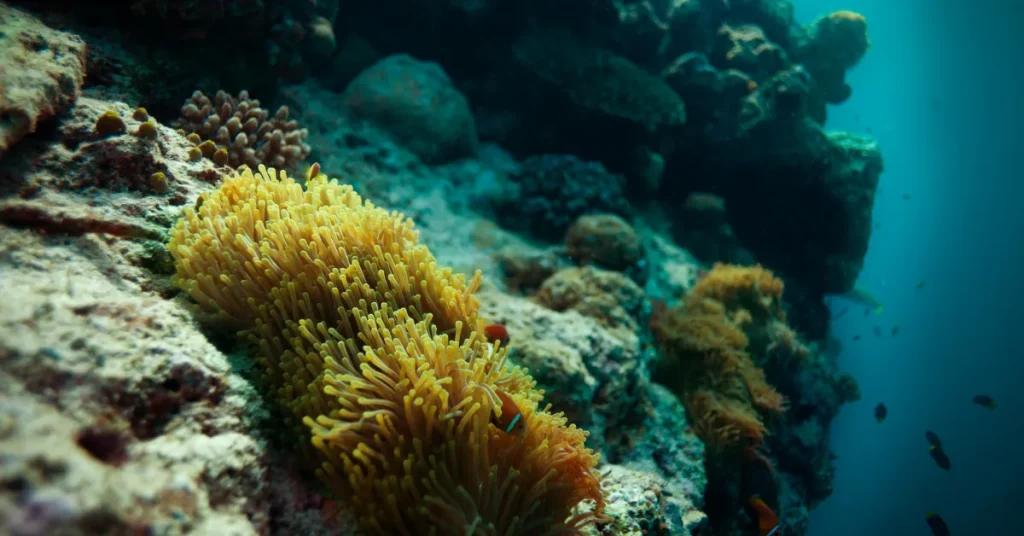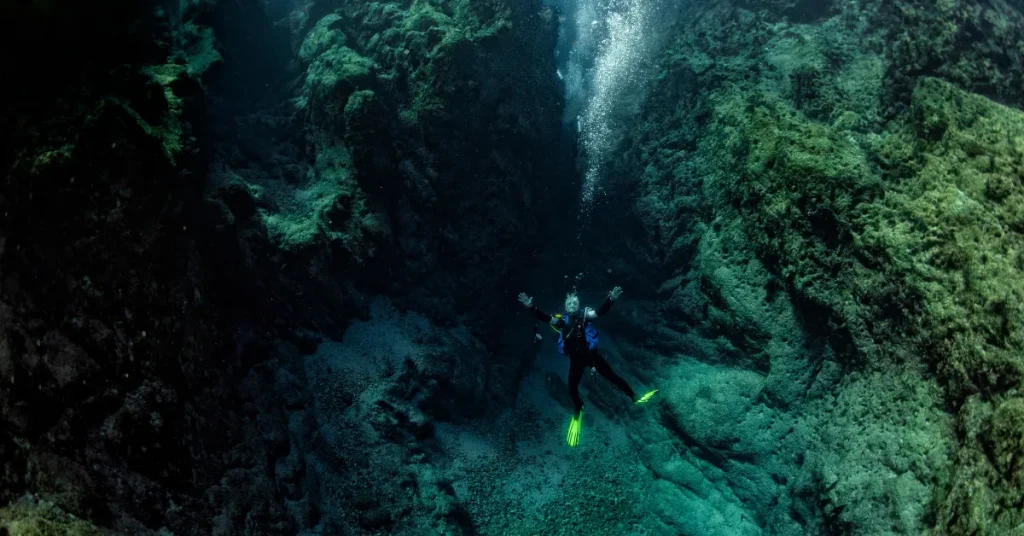The average depth of the oceanic abyssal zone is about 4,000 to 6,000 meters deep. The Abyss refers to these deep sea regions, often shrouded in mystery.
The abyssal zone, a layer of the ocean that extends from about 4,000 meters to 6,000 meters beneath the surface, is a realm of perpetual darkness, immense pressure, and frigid temperatures.
Acting as the final frontier on Earth, the abyss challenges explorers and scientists alike with its harsh and inhospitable conditions.
Home to a variety of unique and often bizarre life forms, the abyss is a critical subject of study for understanding biodiversity and the dynamics of Earth’s climate.
As technology advances, our capacity to explore deeper increases, offering glimpses into this enigmatic world that holds keys to the planet’s past, present, and future.

The Fascination With The Abyss
The abyss, a term often used to describe the profound depths of the ocean, captures our imagination like little else. This vast expanse, hidden beneath waves, invites mystery and speculation about its enigmatic nature.
From marine wonders to the very cradle of folklore, the abyss holds secrets away from the reach of sunlight, lying in wait for the daring souls who seek to uncover its depths.
Humanity’s Draw To The Deep Unknown
There’s a magnetic pull that the abyss exerts on the human psyche. We find ourselves enchanted by the untouched and unexplored. The allure of the deep sea is complex and multilayered.
It beckons scientists eager to uncover ecological truths, adventurers chasing the thrill of the uncharted, and philosophers pondering our place in the vastness of the cosmos.
- Intrinsic curiosity about what lies beneath
- The thrill of exploration and discovery
- A quest for scientific knowledge and understanding
Cultural Portrayal Of Oceanic Depths
Culture depicts the oceanic abyss as a realm of wonders and terror. In literature and film, these depths host mythical creatures and lost civilizations. The stark contrast between the deep’s serene beauty and its potential for danger strikes a chord in our collective imagination.
| Cultural Expression | Representation |
| Mythology | Creatures like the Leviathan and mermaids |
| Literature | Tales of adventure and peril like “Twenty Thousand Leagues Under the Sea” |
| Film | Exploration of the unknown in movies like “The Abyss” |
As we continue to peer into the depths, the oceanic abyss remains not only a physical frontier but also an enduring emblem of mystery in our worldwide culture.
Geography Of The Deep Ocean

The deep ocean is a vast, shadowy world with deep-sea mountains, canyons, and abyssal plains. These underwater landscapes are as varied and dramatic as those we find on the surface.
Yet their remoteness and pressure-filled environments make them less known and hardly fathomable. Let’s voyage into the depths to understand the geography of this mysterious underwater terrain.
Mapping The Ocean Floor: Trenches, Ridges, And Plains
The ocean floor is a tapestry of trenches, ridges, and plains. Advanced technology paints a clearer picture of these features:
- Trenches are deep, narrow valleys in the sea bed.
- Ridges are underwater mountain ranges with peaks and valleys.
- Plains are vast flat areas that cover major parts of the ocean floor.
Sonar technology, known as echosounding, sends sound pulses to map these formations. It’s similar to how bats use echo to navigate in the dark. This mapping helps scientists understand earth’s outer layer movements.
The Mariana Trench: The Deepest Point
At the heart of the Pacific Ocean lies the Mariana Trench. It’s the deepest known point in Earth’s seabed, called the Challenger Deep. Imagine Mount Everest turned upside down and submerged, and you’re still not there yet!
Here are some quick facts:
| Location | Western Pacific Ocean |
| Depth | More than 36,000 feet (nearly 11,000 meters) |
| Explored by | Submersibles like the Trieste, Deepsea Challenger, and DSV Limiting Factor |
Due to extreme pressure and darkness, life here is scarce, yet some species thrive. The Mariana Trench remains a symbol of our planet’s profound mysteries.
The Science Of Depth Measurement
Measuring the deep sea presents unique challenges. Scientists need precise methods to reveal mysteries hiding below. This science is crucial for understanding Earth’s least explored places.
Techniques For Measuring Ocean Depth
Long ago, sailors dropped lines to gauge depth. Today, experts use sophisticated tools for accuracy. Let’s explore these techniques:
- Echo Sounding: Ships emit sound waves downward. They bounce back, revealing depths.
- Satellite Altimetry: Satellites measure sea surface bumps. They indicate underwater features.
- ROVs: Remotely Operated Vehicles dive deep. They map the seafloor’s landscape.
Advancements In Deep-sea Technology
Technology has transformed deep-sea exploration. Cutting-edge innovations provide far more data than ever before. Here are key advancements:
| Innovation | Description | Impact |
| AUVs | Autonomous Underwater Vehicles operate without a human pilot. | They collect data from remote areas. |
| Sonar Technology | Improved sonar systems offer finer detail. | Researchers gain better images of the seafloor. |
| Deep-sea Drilling | Drills penetrate the seabed, retrieving samples. | They allow analysis of underground layers. |
Life In Extreme Environments

Imagine a world where pitch-black waters hug life unbeknownst to sunlight. This world, known as the abyss, is home to Earth’s most extreme environments. The pressure is crushing, the darkness eternal, and food scarce.
Yet, astonishingly, life thrives in these deep-sea conditions. Let’s dive into the adaptations and discoveries that spotlight the incredible life in these depths.
Adaptations Of Abyssal Creatures
Life in the depth of the ocean has led to some remarkable evolutionary tweaks. Here are key adaptations:
- Bioluminescence: Many creatures generate their own light for communication and to attract prey.
- Slow metabolism: This helps conserve energy in an environment where food is rare.
- Pressure-resistant structures: Cellular adaptations allow these creatures to withstand immense pressure.
- Expandable stomachs: To maximize rare feeding opportunities, many species have adapted to consume prey larger than themselves.
These adaptations ensure survival in the abyss where humans dare not tread without advanced technology.
Discoveries Of New Species In The Deep
Exploration in the abyssal plains is uncovering new species regularly. Each discovery sheds light on life’s resiliency. Fascinating finds include:
- The Hadal Snailfish residing at 8,000 meters, adapting to life deeper than any other fish.
- Giant Isopods, looking like oversized pill bugs, show how life can grow to unexpected sizes in the deep.
- New kinds of blind shrimp near hydrothermal vents, revealing intricate symbiotic relationships.
These discoveries expand our understanding of biodiversity and the limits of life on Earth.
Exploration And Preservation Efforts
The deep abyss, an underwater realm shrouded in mystery, beckons scientists and conservationists alike. These depths offer insights into our planet’s history and future. Ongoing efforts to explore and preserve this environment are crucial.
They unfold the secrets of biodiversity and geological formations miles beneath the ocean surface.
The Pursuit Of Deep-sea Research
Deep-sea research is a quest for knowledge. Modern technology allows scientists to reach new depths. Submersibles and remote-operated vehicles dive into the dark corners of the ocean. They bring back information and samples for study.
- Sonar mapping creates pictures of underwater landscapes.
- Submarines send back data from the deep.
- Scientists study extreme life forms that live in the abyss.
Conservation Of The Earth’s Last Frontiers
The abyss is one of Earth’s final frontiers. It is vital to conserve its rich, unique ecosystem. International agreements protect these places from overfishing and pollution. Marine protected areas (MPAs) are key to this effort.
- MPAs limit human activities to reduce impact.
- Strict regulations govern deep-sea mining and resource extraction.
- Public awareness campaigns highlight the abyss’s importance.
| Effort | Impact |
| Research | Improves knowledge of deep-sea ecosystems. |
| Conservation | Preserves unique marine life for future generations. |
FAQs About How Deep Is The Abyss
What Is The Depth Of The Abyss?
The Abyss, often referring to the deepest part of the ocean, reaches depths of about 6,000 meters (20,000 feet). This region, known as the hadal zone, is profound and largely unexplored.
Are There Creatures Living In The Abyss?
Yes, despite extreme conditions, life exists in the Abyss. Species like the giant squid, anglerfish, and deep-sea shrimp have adapted to the high pressure, low temperatures, and absence of light.
How Do Scientists Explore The Abyssal Depths?
Scientists use advanced technology like remotely operated vehicles (ROVs), autonomous underwater vehicles (AUVs), and manned submersibles like the Alvin to study and explore the Abyss.
Why Is The Abyss Important For Research?
The Abyss holds clues to Earth’s early life and extreme life forms. Studying it helps us understand global climate patterns and potential medical and biotechnological breakthroughs through unique marine organisms.
Conclusion
Exploring the abyss remains a remarkable journey into Earth’s vast mysteries. The depths are staggering, challenging our understanding of the planet.
Each descent unravels hidden secrets, beckoning brave souls to delve deeper. So, we continue, seeking knowledge in the ocean’s elusive heart, where darkness reigns supreme and silence speaks volumes.
Resources:
1. https://science.nasa.gov/earth/oceans/nasa-study-finds-earths-ocean-abyss-has-not-warmed/
